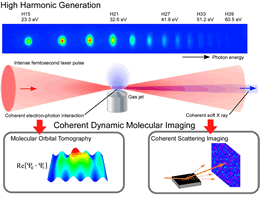|
 
 |
|
| @Curriculum Vitae |
y Education z |
| Jiro Itatani received the B.S. and M. S. degrees in physics and the Ph. D. degree in applied physics from the University of Tokyo.While he was a graduate student, he stayed at the NSFCenter for Ultrafast Optical Sciences at the University of Michigan as a research investigator. |
y Professional appointments z |
| After received the Ph. D., he became a postdoc at RIKEN, then a postdoc at National Research Council Canada, worked on high-peak-power lasers, high harmonic generation, and dynamic molecular imaging.2004-2007, he joined the JST-ERATO non-equilibrium dynamics project, worked on the development of novel ultrafast techniques for strongly correlated materials at the Lawrence Berkeley National Laboratory. @In 2008, he joined the JST-PRESTO , 2008-@ Associate Professor,The University of Tokyo, The Institute for Solid State Physics. |
| Research interests |
His current research interest ranges from ultrafast lasers and synchrotrons to their applications to attosecond physics and dynamic molecular imaging.

|
|
| @ Introduction of the project |
| Watching atoms and molecules move on their natural time scales is one of the dreams of scientists for a long time.There are several methods to resolve individual atoms and molecules, such as diffraction and microscopy using short wavelength electrons or x-rays, or scanning microscopy with atomic-scale tips.These methods, however, do not have enough temporal resolution to trace the dynamics of complex quantum systems on their natural time scales that are on the order of picoseconds to femtoseconds for intra-molecular atomic motions, or femtoseconds to attoseconds for the electron dynamics of highly excited atoms and molecules.Meanwhile, ultrafast laser spectroscopy can routinely trace various quantum dynamics on the femtosecond time scales. Their spatial resolution is, however, limited to sub-microns by the laser wavelength.In the past decade, new techniques that have both spatial and temporal resolution are getting highly desirable to understand complex quantum systems, especially in the fields of condensed matter physics, quantum chemistry, and molecular biology.Such measurement techniques are indeed being pursuit intensively by expanding various technologies such as next generation synchrotrons.In this research project, we will develop dynamic molecular imaging methods that are based on the coherence of high harmonics.High harmonics are coherent and broadband soft x-rays that are produced by focusing intense ultrashort laser pulses into gas media. We believe that these methods have a potential to break the barrier of spatial resolution of laser wavelength, and to realize methods to directly observe atoms and molecules move on their natural time scales.We will specifically concentrate on the following two approaches.
First, we will develop a method to reconstruct the spatial structure of an intramolecular electron wavefunction by using the electron-photon coherence embedded in high harmonic generation.This method, molecular orbital tomography, was originally discovered by the researcher of this proposal.We will further elaborate this method for measuring the electronic structures of gas phase molecules without assumptions.
Second, we will develop a laser-based coherent scattering imaging that should enable us to reconstruct nano-scale structures in solids. Through this development, we aim to obtain indispensable knowledge on the fluctuation and dynamics of the ferroelectric domains in strongly-correlated materials.
The two methods above are seemingly different, but indeed have strong similarities - the spatial structures are not directly measured but coherently projected onto another dimension by Fourier transform. We will develop these methods to establish coherent dynamic molecular imaging based on ultrafast laser technologies.

|
|
| £UP |
|
|
|

